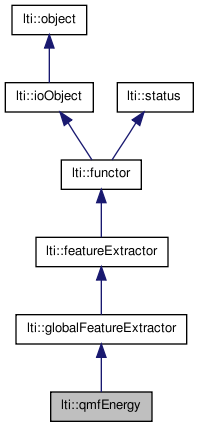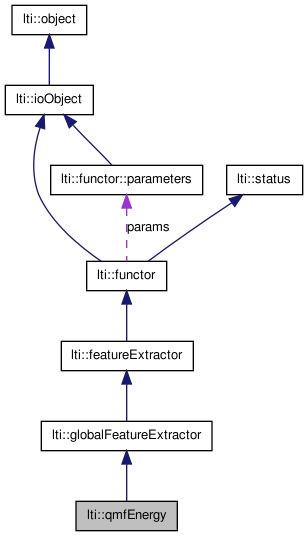

|
latest version v1.9 - last update 10 Apr 2010 |
|
The qmfEnergy is a functor for extraction of texture features. More...
#include <ltiQmfEnergy.h>


Classes | |
| class | parameters |
| the parameters for the class qmfEnergy More... | |
Public Member Functions | |
| qmfEnergy () | |
| qmfEnergy (const parameters ¶m) | |
| qmfEnergy (const qmfEnergy &other) | |
| virtual | ~qmfEnergy () |
| virtual const char * | getTypeName () const |
| bool | apply (const image &src, dvector &feature) const |
| bool | apply (channel &srcdest) const |
| bool | apply (const channel &src, channel &dest) const |
| bool | apply (const channel &src, dvector &dest) const |
| qmfEnergy & | copy (const qmfEnergy &other) |
| virtual functor * | clone () const |
| const parameters & | getParameters () const |
Protected Member Functions | |
| void | getChannels (const channel &chnl, std::vector< channel > &chnls) const |
| void | padChannel (const int &levels, const channel &chnl, channel &padchnl) const |
The qmfEnergy is a functor for extraction of texture features.
As described in Alvarado et. al. "Axon2 - A visual object recognition system for non-rigid objects" SPPAM 2001.
The channel will be separated using a QMF-Bank in several frecuency channels. After that the "energy" is calculated by applying the square function to each pixel. The resulting energy subchannels can be filtered using the so called "powerFilter". All channels are merged by upsampling the "smaller" resolutions or alternativelly by downsampling the higher resolutions.
The resulting images can be convolved with a gaussian kernel. The last optional step for the qmfEnergy is to apply the square root to each pixel.
From the resulting image an histogram can be generated.
| lti::qmfEnergy::qmfEnergy | ( | ) |
default constructor
| lti::qmfEnergy::qmfEnergy | ( | const parameters & | param | ) |
Constructor with parameters.
| lti::qmfEnergy::qmfEnergy | ( | const qmfEnergy & | other | ) |
copy constructor
| other | the object to be copied |
| virtual lti::qmfEnergy::~qmfEnergy | ( | ) | [virtual] |
destructor
extract the histogram of the energy image calculated from the given channel.
operates on a copy of the given parameters.
| src | channel with the source data. | |
| dest | feature vector generated as a histogram of the energy image |
Reimplemented from lti::globalFeatureExtractor.
| bool lti::qmfEnergy::apply | ( | channel & | srcdest | ) | const |
extract histogram of energy image for each color channel of the given image.
| src | image with the source data. | |
| feature | the feature vector generated by the concatenation of the feature vector for each separated color channel RGB. |
Reimplemented from lti::globalFeatureExtractor.
| virtual functor* lti::qmfEnergy::clone | ( | ) | const [virtual] |
returns a pointer to a clone of this functor.
Reimplemented from lti::globalFeatureExtractor.
copy data of "other" functor.
| other | the functor to be copied |
Reimplemented from lti::globalFeatureExtractor.
| const parameters& lti::qmfEnergy::getParameters | ( | ) | const |
returns used parameters
Reimplemented from lti::globalFeatureExtractor.
| virtual const char* lti::qmfEnergy::getTypeName | ( | ) | const [virtual] |
returns the name of this type ("qmfEnergy")
Reimplemented from lti::globalFeatureExtractor.
| void lti::qmfEnergy::padChannel | ( | const int & | levels, | |
| const channel & | chnl, | |||
| channel & | padchnl | |||
| ) | const [protected] |
pad the source channel to have the proper dimensions